Science takes the stage at CSU Spur
New research model supports collaboration, connection and innovation story by Anthony Lane published April 19, 2023On a recent Monday, while tending the leafy greens and herbs growing in a research greenhouse at CSU Spur, Oliver Fulton glanced up to find he had visitors in the sun-drenched space on the Terra building’s fourth floor.
He didn’t notice, at first, a television news crew that accompanied the group, and instead focused on his primary audience, a cluster of 10 or so grade schoolers in matching blue shirts. He started calibrating his remarks, plotting how best to convey the basics of hydroponics and controlled environment horticulture. He prepared for questions, diverging interests, and the familiar challenge of communicating science in a space where grow towers, mist sprayers, and the plants themselves all vie for attention.
“Within five minutes I was miked up,” said Fulton, a 23-year-old student at Colorado State University pursuing a master’s degree in horticulture. He went on to describe his work and the equipment he uses, showing how he controls plants’ access to water, nutrients, and light in search of combinations that make them grow best.
Only as the group from the Boys and Girls Club of Metro Denver prepared to leave did he ask about the news crew. They were working on a story about the club’s partnership with CSU Spur, and the piece would air on the Denver CBS station’s news broadcast the next evening.
Later, after the broadcast, Fulton laughed as he considered what he might have said differently had he been thinking about that larger audience.
“You know, I didn’t even think twice about it because what I did there is something that I’m doing almost every day I’m here,” Fulton said.
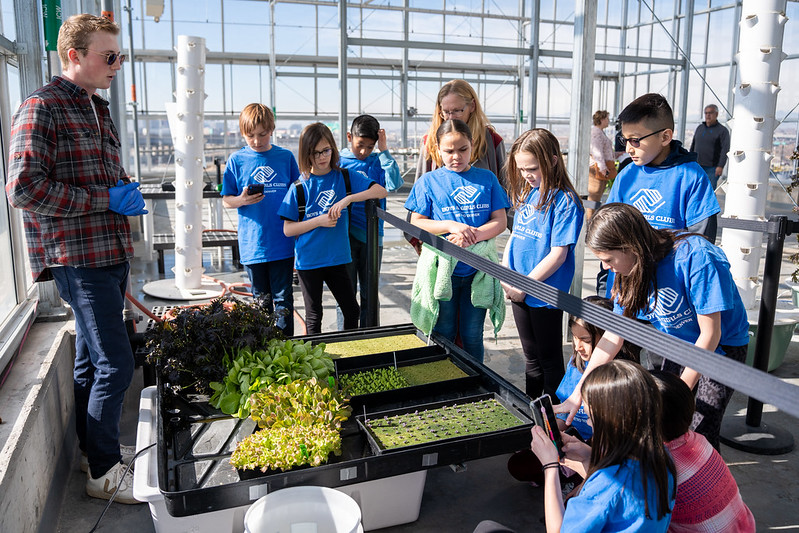
Oliver Fulton, a CSU graduate student, explains the techniques used in controlled environment horticulture to a group from the Boys and Girls Club of Metro Denver.
For scientists at the CSU Spur campus in north Denver, the frequent need to communicate with different audiences reflects a decade-long planning and design process that centered on developing a new model for connecting the public with researchers and the steps they take to address societal problems. Tony Frank, chancellor of the CSU System, described the evolution of those plans, and a resulting campus that functions, in many ways, like a special kind of theater, with science and the creative process occupying its stage.
“To me, what’s really unique about the research at Spur is that it is designed to be observed, and designed to have an impact, especially on kids who may not have seen college as a viable pathway,” Frank said.
Since opening in January 2022 following completion of the health-focused Vida building, CSU Spur has hosted close to 7,000 preK-12 students from schools in Colorado and beyond for facilitated visits. The now-complete campus expanded in the past year with the opening of the food-themed Terra building in June and then completion of the Hydro building, focused on water, this past January.
“To me, what’s really unique about the research at Spur is that it is designed to be observed, and designed to have an impact, especially on kids who may not have seen college as a viable pathway.”
— Tony Frank, Chancellor of the CSU System
In slightly more than a year, the campus, part of a broader redevelopment of the National Western Center in Denver, has welcomed about 50,000 visitors, including families, youth groups, area residents, and many others.
Layers of purpose
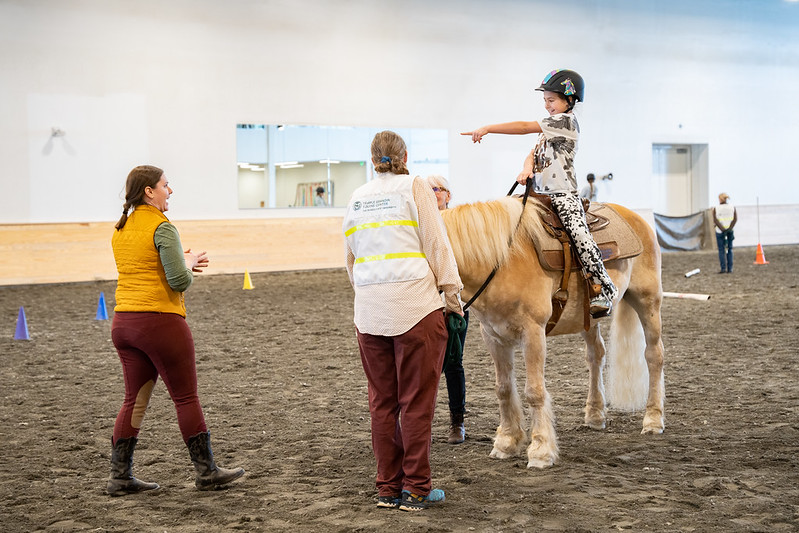
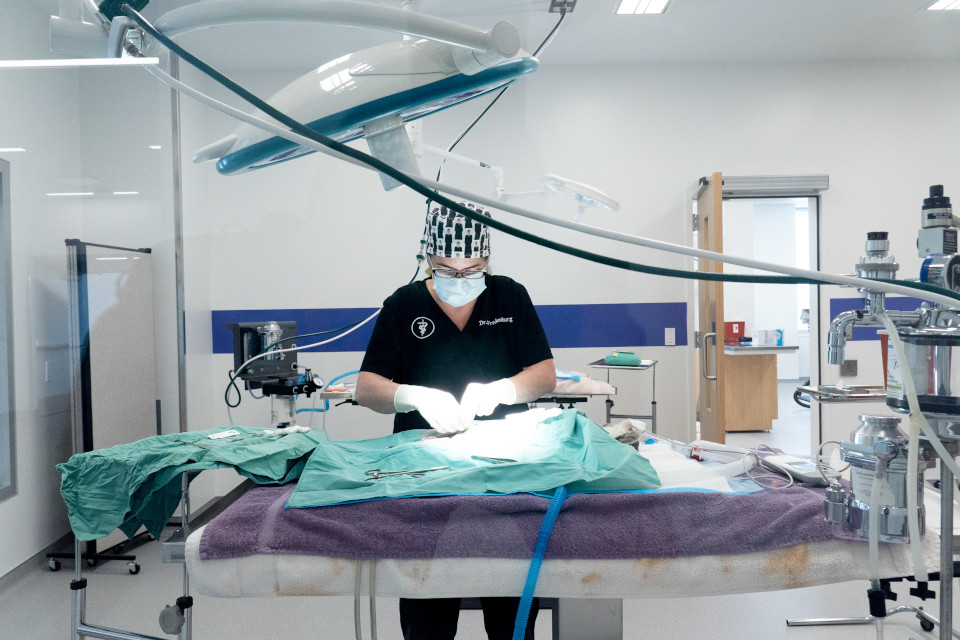
The Temple Grandin Equine Center provides equine-assisted services and is also studying the impact such services have on clients, and the Dumb Friends League Veterinary Hospital is an active hospital providing urgent care services for those who otherwise wouldn’t have access to veterinary care.
Visitors to CSU Spur have the opportunity to engage with science from the moment they enter each building. On the first floor of the Vida building, glass panels and a live video feed let them watch dogs and cats undergoing surgery at the Dumb Friends League Veterinary Hospital. Upstairs, they can see horses working out injuries at the Equine Sports Medicine and Rehabilitation Center, or they can observe therapy sessions in progress at the Temple Grandin Equine Center.
The Temple Grandin Equine Center illustrates how activities at CSU Spur have layers of purpose. Through windows on the second floor, visitors can look out on the arena below as clients on horseback receive therapy for conditions ranging from autism and cerebral palsy to post-traumatic stress disorder.
With the arena at CSU Spur and another facility in Fort Collins, the center is able to provide thousands of therapy sessions each year. The Denver arena extends the center’s geographic reach along the Front Range and also gives its programming a new level of visibility. Adam Daurio, director of the center, said the work at CSU Spur is both about the public component and the underlying science.
“We are helping to advance a role for animals in society,” Daurio said. Part of this involves answering questions that are as profound as they are practical: “What is this human-animal bond? What does being around a horse do for a human?”
One practical aspect of the center’s work is that insurance companies and other funders want evidence that equine assisted services are effective. With its two facilities, the center is moving ahead to provide that evidence, including through a two-year quantitative study, starting in May and funded by the National Institutes of Health, examining the impacts of equine assisted therapy on autistic youth.
Conducting research, raising awareness, and building trust and connections are also goals for the Translational Neurological Lab at CSU Spur. For the lab’s researchers, who are based in Fort Collins, having physical space in the state’s most populous region multiplies opportunities to secure grants and assess the impact of different interventions on people with brain injuries. While patient confidentiality demands at times that treatments occur out of public view, a key aspect of the lab’s work involves finding ways to “demystify neuroscience” and engage with community members.
“We want people to trust medical advances,” said Jen Weaver, an assistant professor of occupational therapy who co-directs the lab with Arlene Schmid, a professor of occupational therapy, and Jaclyn Stephens, an assistant professor in the same department. As scientific understanding deepens and tools grow more sophisticated, she continued, the question becomes, “How do we give that knowledge back to the community?”
At CSU Spur, that occurs in part at “2nd Saturday at CSU Spur” open houses held each month, as well as during the National Western Stock Show in January, and on other occasions when the campus comes alive with special demonstrations and activities. Equipped with a functional near infrared spectroscopy (fNIRS) system, Stephens has given visitors on these days the chance to observe how the instrument detects and displays the patterns of brain activity associated with different tasks.
“We’re trying to make the line between the public and research more fluid,” Stephens said.
Opportunities to connect and engage
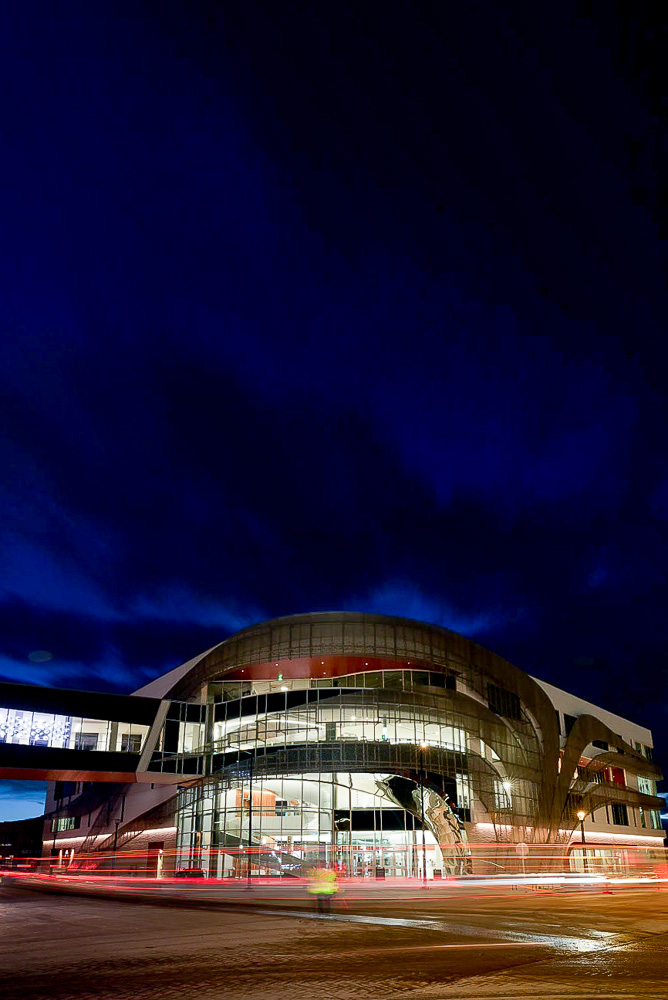
The CSU Spur Hydro building, which opened in January, focuses on water and serves as a platform for water education, research, innovation and policy.
Other activities centered at CSU Spur move from bringing the public in contact with science to conducting science in partnership with them. In 2019, with construction of the campus just beginning, Greg Newman, a research scientist and ecologist at CSU’s Natural Resource Ecology Laboratory, set out to track the impact of restoration efforts along the adjacent South Platte River.
At regular “bioblitzes,” Newman and a team of volunteers don waders and unfurl nets to count and inventory key indicator species.
Proximity to the South Platte River and the unique attributes of a campus built at the National Western Center have other benefits for researchers and educators focused on sustainability. Sybil Sharvelle, a CSU professor of civil and environmental engineering, is working with colleagues in the final stages of preparations to get her lab, the Water Technology Acceleration Platform, or Water TAP, up and running.
The lab, located in the Hydro building, will take advantage of having access to water from multiple sources, including rainwater from the building’s roof, graywater from its showers and sinks, treated wastewater, and stormwater from the grounds of the National Western Center. Sharvelle and colleagues will assess the quality of water from different sources and then try out technologies and techniques to treat each for differing “fit-for-purpose” uses.
Sharvelle sees CSU Spur as being both organized and situated in ways that will enable “top class” science.
“As soon as I started my career, I would have wanted a lab like this,” she said. An engineer’s measured excitement comes through as she talks about the lab’s progress and the prospect of soon examining stormwater in which runoff from nearby industrial zones mingles with water draining from the agriculture-intensive facilities of the National Western Center. “It should be really dirty.”
In addition to developing, refining, and documenting the effectiveness of new approaches for testing and treating less-than-pristine water, Water TAP is gearing up to offer professional development opportunities, including certification for irrigation specialists and others working in the water sector. The lab is also part of one significant constellation of activities at CSU Spur with the potential to connect with the community and its needs while driving innovation and business development.
Brian Elizardi, who is based at CSU Spur as the director of community impact and innovation for CSU’s College of Business, sees these constellations emerging naturally out of a campus designed to welcome the community and the broader society.
Through CSU Extension and an array of non-degree and other programs, he said, the CSU System and its campuses have long demonstrated how higher education can engage with the community: “This just takes that and puts it on steroids.”
Open by design
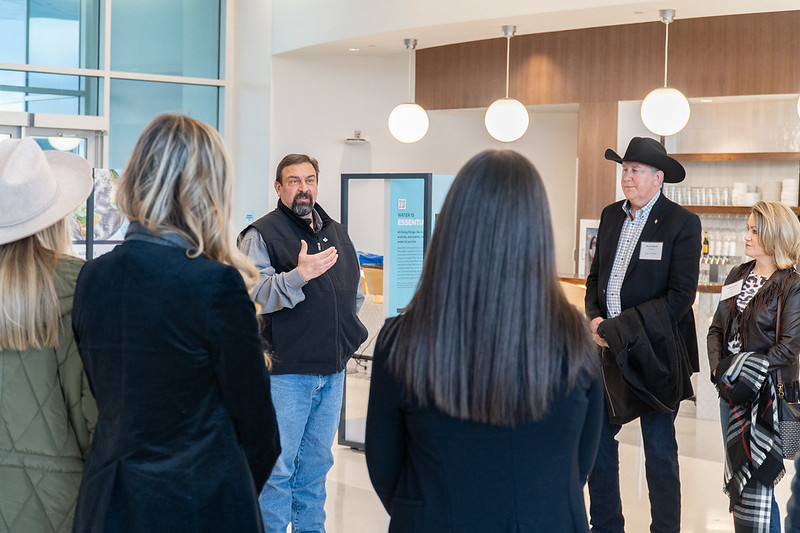
CSU System Chancellor Tony Frank meets with leaders from the Colorado Business Roundtable during a tour of the CSU Spur campus.
In keeping with the university’s land grant mission, CSU’s College of Agricultural Sciences has long worked with producers in providing research-based support and advice through a statewide network of agricultural experiment stations. The college’s 10th of these centers, the Metropolitan Ag Research Center, or MARC, is based in the Terra building at CSU Spur, where it complements a host of other programs and initiatives focused on sustainable food production and innovation.
Jake Holley, a research scientist and co-manager of MARC, oversees operations in Terra’s rooftop research greenhouse and in growth chambers within the building. A 300-gallon koi tank in the greenhouse will soon provide new options to develop and test systems involving aquaponics, the combination of fish and plant production.
Less visible to visitors, new technology in the greenhouse will allow researchers to track “by the minute” how much water plants are using. “It creates a gold mine in terms of understanding,” Holley said.
Beyond research opportunities, the greenhouse and growth chambers support local start-up companies needing to test new products in controlled environments, and they will provide a setting for certification classes and other courses. In time, Holley expects these spaces to yield 50-75 pounds of fresh produce each week.
While some of these leafy greens, herbs, and other fruits and vegetables will be sent off site to local nonprofits, much will be used within the Terra building, for product development and testing within the Food Innovation Center, or at the Hydro building, where it could show up in dishes served by Western Daughters Kitchen.
The Food Innovation Center offers multiple services, including product development support, a culinary development kitchen, and sensory research spaces. Josh Craver, an assistant professor in CSU’s Department of Horticulture and Landscape Architecture, said the clustering of programs and facilities invites new approaches and consideration of different perspectives. With access to tasting booths, for example, researchers can move beyond horticultural prowess to think about marketability.
“We can produce some of the most red, red leaf lettuces, but what does that mean for consumers?” Craver asked.
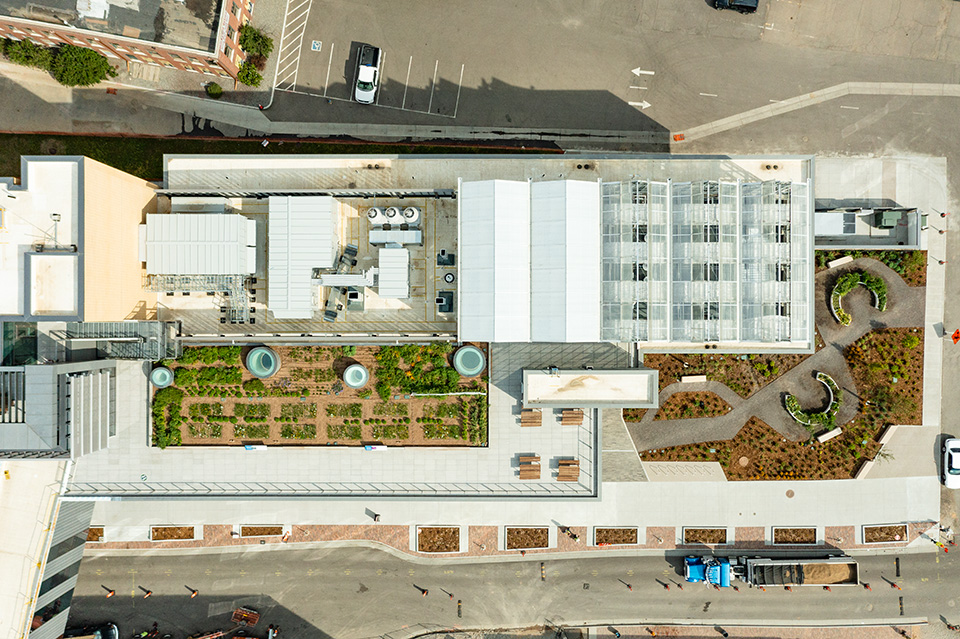
The rooftop garden on the Terra building is helping researchers learn how best to grow plants in a rooftop environment as well as which green roofs can help reduce stormwater runoff and provide other benefits.
Outside the greenhouse on the Terra building’s fourth floor is one of CSU Spur’s two research green roofs. This past summer, it produced more than 350 pounds of produce, including tomatoes, peppers, cilantro, and chives, as well as medicinal plants, and flowers favored by pollinators. Research based on that first growing season will be the focus of up to four presentations at the World Green Infrastructure Congress, occurring in late June in Berlin.
This year, Jennifer Bousselot, a CSU assistant professor of horticulture, along with colleagues and students, is preparing for a second growing season on the Terra building’s roof while establishing a second research space on top of the Hydro building. The latter will allow researchers to examine strategies and techniques for growing plants beneath and alongside solar panels, a field of study known as rooftop agrivoltaics.
Like Oliver Fulton and other researchers at CSU Spur, Bousselot is accustomed to speaking with the many and varied visitors who stop by on tours or explore the campus on their own. A broad trend in scientific research has been toward openness, both in terms of the methods used and the discoveries that result. Bousselot sees how research at CSU Spur advances that trend, with the interplay of design and public interaction extending what is possible. “We can use this space as a platform to magnify the work,” she said.
Collaboration possibilities extend beyond the campus and have room to develop within it. “It’s almost like a makerspace,” Bousselot said. Describing conversations she’s had with Sybil Sharvelle about the potential for testing different water sources in rooftop agriculture systems, she sounds both excited and surprised. The fit is obvious, and yet academic and disciplinary traditions have long resisted such connections. “I’m a farmer and she’s an engineer,” she explained with an almost audible shrug.
Expanding what’s possible
For Jim Bradeen, CSU’s associate vice president for CSU Spur strategy, an important goal as new programs and initiatives start at the campus is creating and maintaining the space for such conversations to occur. Beyond the physical design of the campus, he said, are events and activities, including an orientation program and periodic meet and greets, that deemphasize boundaries and focus on shared goals.
A planned internal lecture series, Bradeen said, aims to build community and broaden awareness of ongoing research while reinforcing the idea that the campus is “not just a place to do things.”
Eugene Kelly, a CSU professor of soil science and deputy director of the Colorado Agricultural Experiment Station, was involved from the beginning in discussions about the development of CSU Spur and the creation of a new kind of research space in Denver.
Establishing an agricultural presence and familiarizing people with the complexities of the food production system were always important goals, and they’ve come to seem more urgent in recent years. News about drought and water shortages in the Colorado River basin have focused attention on doing more with less and on developing new techniques, technologies, and approaches.
Now the campus’s three buildings are complete, and the vision for a research outpost in Denver is starting to be realized. And there’s something more. Leading a tour one day for some “big foodie guys,” Kelly noticed a woman nearby who appeared puzzled, and he stopped to help her and her kid. He told them which exhibits to see, suggested they check out the development kitchen and the tasting rooms, and advised them to “keep coming back because it’s an easy place to get to” and the programming changes often.
“There are so many opportunities like that, and they mean a lot to people,” Kelly said. “I think the opportunity is to really close that gap between the ivory tower of the university and the public.”
The things happening at CSU Spur – the research, the teaching, the connecting – are only part of the story. Kelly describes being on the top of the Terra building, at a campus expanding what’s possible in the agricultural sciences, and then simply taking in the view.
“I think the opportunity is to really close that gap between the ivory tower of the university and the public.”
— Eugene Kelly, CSU professor and deputy director of Colorado Agricultural Experiment Station
“It’s just remarkable looking over the entire city of Denver and then looking out east at all that ranch land and all that farmland,” he said. “I think that the opportunity for us is really about elevating, about being so transparent and open that people come in and gain an enormous amount of knowledge about the way food is produced and ways to live healthfully.”
About CSU Spur
CSU Spur is a new, free learning destination open year-round in Denver, focused on engaging K-12 students, families, and visitors around food, water, and health. CSU Spur showcases the work of the CSU System campuses: CSU, CSU Pueblo, and CSU Global, while advancing knowledge on topics in food, water, health and sustainability. Spur is built upon the land-grant mission of access to education. To inspire lifelong learners to engage in important world issues, CSU Spur brings together scientists at work with youth and families, showcasing career paths, while creating a space and place for collaboration across disciplines. The CSU Spur campus provides immersive learning experiences and cutting-edge research across three buildings: Vida, Terra, and Hydro. Learn more at CSUSpur.org.